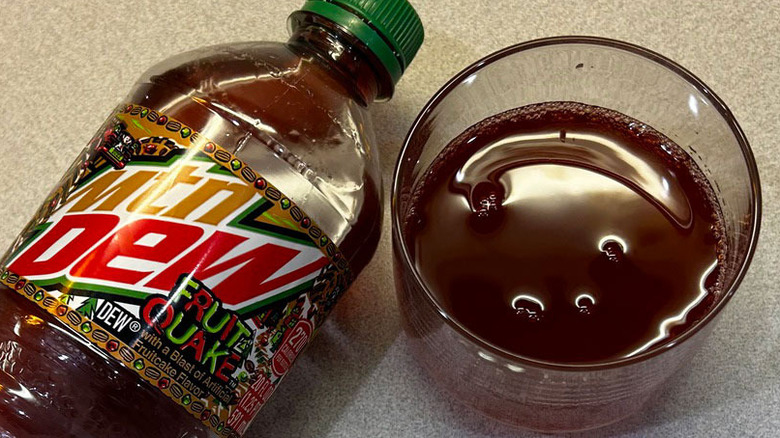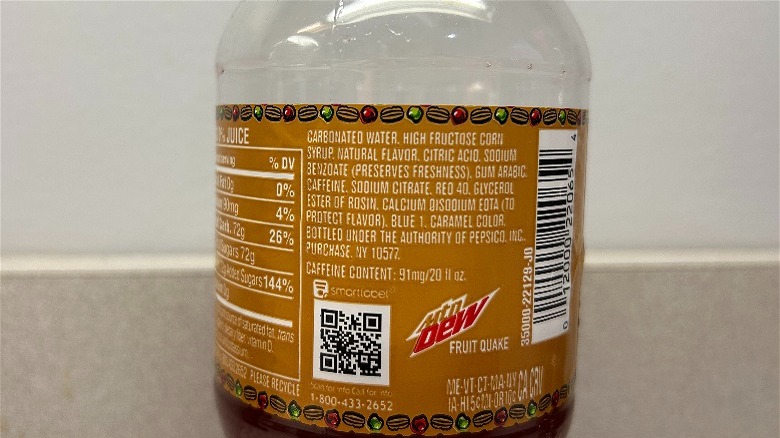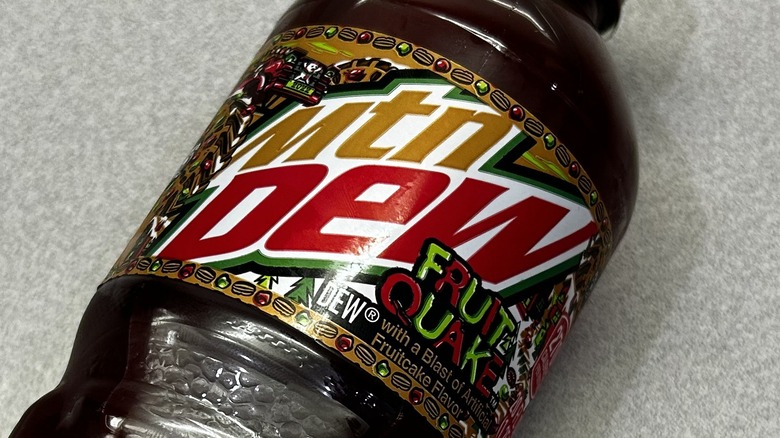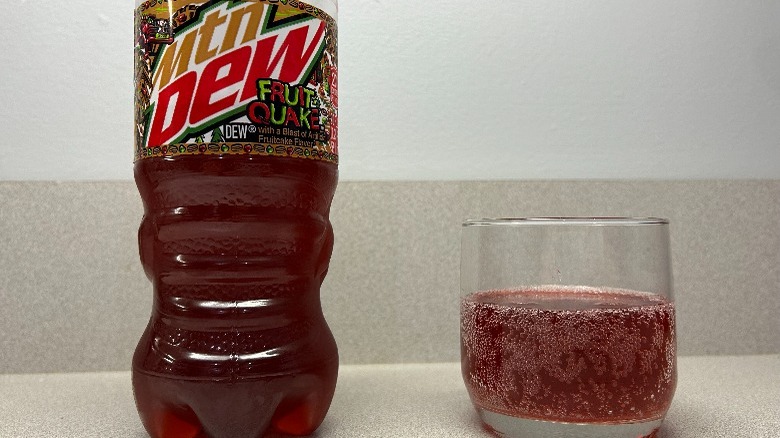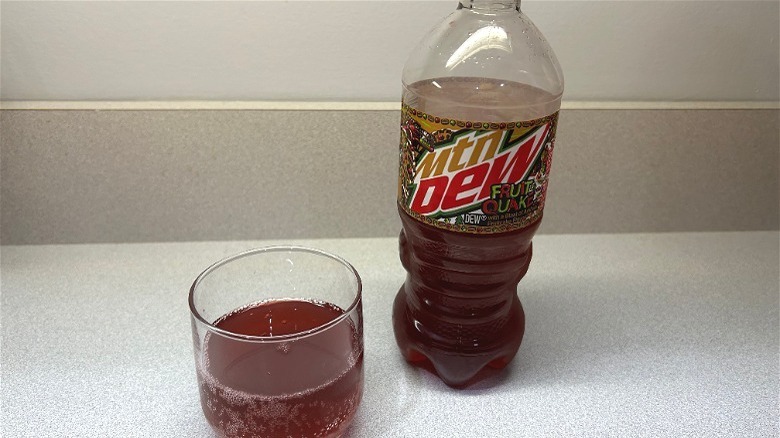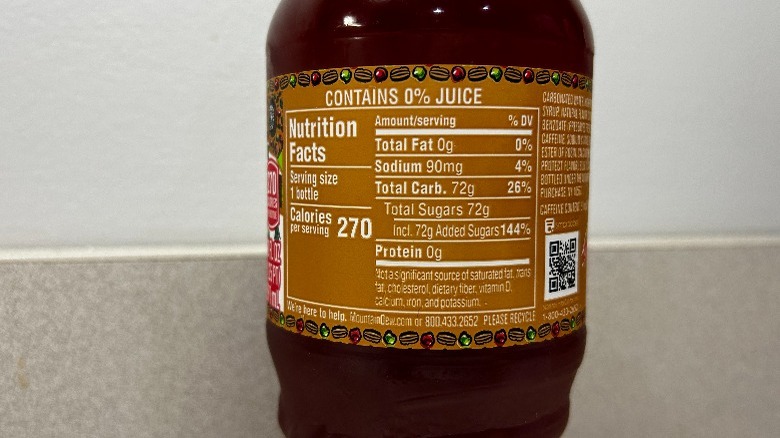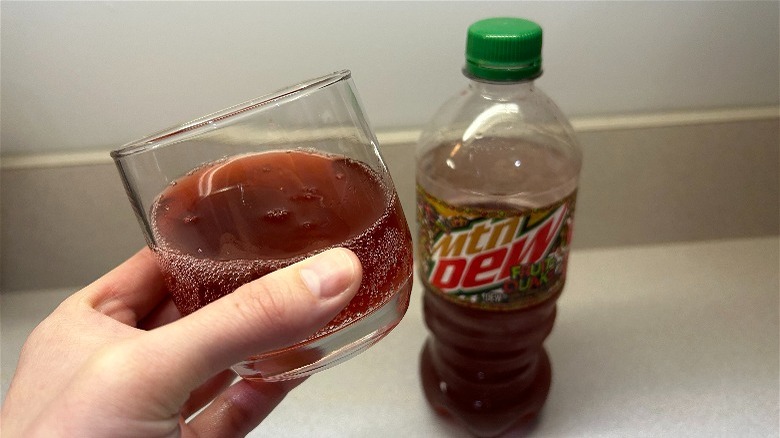We Tried Mountain Dew's Holiday Fruit Quake Flavor. It Was Better Than Expected, Kind Of
We may receive a commission on purchases made from links.
Mountain Dew gets a bad rap, and rightfully so. It's the perfect butt-of-the-joke for every insult that involves sugary sodas. From its fluorescent yellow-green color, to its overwhelming amount of carbonation, Mountain Dew is definitely an experience many folks can live without. Originally launched in 1928, Mountain Dew was intended to be a mixer, originating as a lemon-lime soda that was meant to kick the bite in moonshine (via WBIR).
Past Mountain Dew flavors have been questionable at best, except for the all-mighty Baja Blast Taco Bell aficionados' love and worship. The day after Halloween, though, Mountain Dew announced on Twitter the release of its new holiday flavor — Mountain Dew Fruit Quake, a super-charged, liquified version of everyone's least favorite holiday treat. A spokesperson told Fox 10 Phoenix that this newly-released flavor is "making everyone's holiday dream come true by swapping the dated dessert with a tastier treat."
Naturally, we were skeptical, thinking how two of the most foul-tasting food concoctions modern humans have ever unleashed could be palatable together. However, we decided to take the plunge for the sake of journalism, and at the expense of our stomach lining, to see if it was actually worth the hype, or just another internet meme.
What's in Mountain Dew's holiday Fruit Quake?
Mountain Dew has been in the hot seat, thanks to some of its questionable ingredients. Sure, it's not a kale smoothie, but some of the ingredients look like they belong in the back of a science textbook. In the past, it has been under scrutiny for its use of the dye, Yellow No. 5, with rumors alleging that it negatively affected sperm count and other male-born body parts (via Live Science). Other ingredients have also included brominated vegetable oil, which doubles as a flame retardant for plastic products (per ABC News).
On the bright side, Mountain Dew's Holiday Quake flavor may not contain these controversial additives, but it's chock-full of other interesting and scientific-sounding ingredients. After carbonated water, the second ingredient is high fructose corn syrup — an ingredient that has been linked to an increased risk of diabetes and heart disease (via Healthline). Aside from "natural flavors" and caramel color, there are assorted food dyes, like Blue 1, which in some studies, has been correlated to potentially increased risk of kidney tumor growth (via CSPINET).
However, the amount of caffeine present is probably the most eye-catching — 91 milligrams in a 20-ounce bottle. A study in Coffee Affection found that Mountain Dew was the most caffeine-dense soda on the market, behind Pepsi One and Diet Coke, with about as much caffeine as an 8-ounce cup of coffee. At the end of the day, like this flavor, we are around for a limited time only, so drink what you want.
Where to buy Mountain Dew's holiday Fruit Quake
We purchased the Mountain Dew Fruit Quake drink at our trusty 7-Eleven, but thankfully, it's available at many grocery and convenience stores. According to Brand Eating, the limited-edition flavor is available nationwide in the United States from November 1 through the 2022 holiday season, which most likely means until the end of December. However, keep in mind that it's available while supplies last, since it seems like everyone wants a slice of this new holiday flavor.
You can purchase 12-packs and 20-ounce bottles from online retailers such as Amazon, but also on the Walmart website. You can also use the Mountain Dew store locator to accurately navigate which stores around you potentially have the holiday flavor in stock. If you are that hard up to get your hand on a case, though, you can haggle your time away on eBay if desperate times call for desperate measures.
How much does Mountain Dew's holiday Fruit Quake cost?
For our sip of holiday heaven and hell, we paid approximately $2.50 for a 20-ounce bottle from the local 7-Eleven. Strangely though, it seems like the prices for Mountain Dew's Holiday Fruit Quake soda vary drastically across different retailers. Most online retailers, however, are starting to run out of supplies, inadvertently driving the prices through the roof.
Surprisingly, Amazon is one of the more expensive options, with a 12-pack of 12-ounce cans costing around $22. Meanwhile, a 4-pack of 20-ounce bottles costs an outrageous $35, and that doesn't even include the 2-day Amazon shipping. If purchased online through Walmart, a 12-pack is shockingly almost $30, but that doesn't mean it will cost that much in the store. That being said, you can save a buck or two by buying two 12-packs on the Walmart website for only $39.99. eBay is the nice-ish middle-of-the-road option, with a 12-pack costing $22, but it makes you question if the gamble is really worth the reward. We aren't sure yet if it is.
How Mountain Dew's holiday Fruit Quake compares to other flavors
Mountain Dew's flavors tend to range from drinkable to insufferable in the twist of a cap. However, there's something about this Fruit Quake holiday flavor that is weird and very different from other limited edition and classic options. Of course, it mirrors the original Mountain Dew taste with that forward, yet lingering, artificial citrus essence, except with more holiday cheer packed inside.
Compared to the previous Mountain Dew holiday flavor, Merry Mash-Up, it's more spicy as opposed to fruity-tasting. The Merry Mash-Up flavor tasted like a cranberry-pomegranate love child, with an essence of tartness that was more refreshing as opposed to sweet (per The Impulsive Buy). Mountain Dew Fruit Quake matches the vibe of the grape-flavored, Mountain Dew Pitch Black, with that same level of artificial sweetness.
However, it most closely resembles Mountain Dew Code Red, with both teeming with strong cherry tanginess. That being said, it doesn't hold a candle to our cherished Mountain Dew Baja Blast — a truly unrivaled balance of tropical, sweet, and savory that only an intoxicated person could truly love wholeheartedly.
Mountain Dew's holiday Fruit Quake nutrition facts
It's hard to not respect Mountain Dew slightly, since it never tries to be something that it's not. The brand never claims to be healthier than the rest, and just lives in its truth as the degenerate and toxic middle child of the soda world. That being said, these nutrition facts are purely informational, and not meant to act as a guilt trip if you so choose to fall down this Mountain Dew rabbit hole.
Not-so-shockingly, Mountain Dew snatches the crown for soda with the highest amount of sugar. In a Business Insider study, it found that a 12-ounce can of Mountain Dew had around 46 grams of sugar, with sodas like Cherry Coke having 42 grams of sugar. Mountain Dew's high sugar content has even coined the term, Mountain Dew Mouth, which results in severe tooth decay (via Healthline). In a 20-ounce bottle of Mountain Dew Fruit Quake, there are 72 grams of sugar and 270 calories — a number we have never seen on the back of a soda bottle before.
On the bright side, it has no fat, and is low in sodium. However, it has a high amount of simple carbohydrates, which can cause spikes in blood sugar, and lead to a nasty sugar crash (via WebMD). But like we said, moderation is key when enjoying Mtn Dew.
Our verdict on Mountain Dew's holiday Fruit Quake
At first glance, the color looks eerily similar to Mountain Dew Code Red, especially if it had flecks of burned caramel blended into it. The nose is equally as deceiving, with that same artificially radioactive smell that will forever be associated with the classic Mountain Dew flavor. Except, there are hidden notes of liquified Fruit Roll-up and melted, cherry-flavored SLUSH PUPPiE. You could go as far as to say it smelled like the artificially-sweetened innards of Fruit Gushers, but with a certain spiciness that would make you think Hobby Lobby potpourri, instead of fruit cake.
Naturally, expectations and morale were low, but upon first sip, our mind began to play tricks on us. It tasted exactly as it smelled, and we would even go as far as to say that it is better than the infamously dreadful holiday dessert itself. Sure, after just four or five sips, we could feel the sharp pain of a cavity forming, but what is life without a little spice?
We truly wanted to hate it because, in a perfect world, this is supposed to taste more dreadful than even Mountain Dew's Flamin' Hot Cheetos flavor. But, we found ourselves sneaking guilty sips every now and then, not because we loved and craved it, but because it seemed new and fascinating. We probably wouldn't buy a 12-pack, or replace it with our morning cup of coffee, but we can continue to lie to ourselves as we casually finish the glass.
